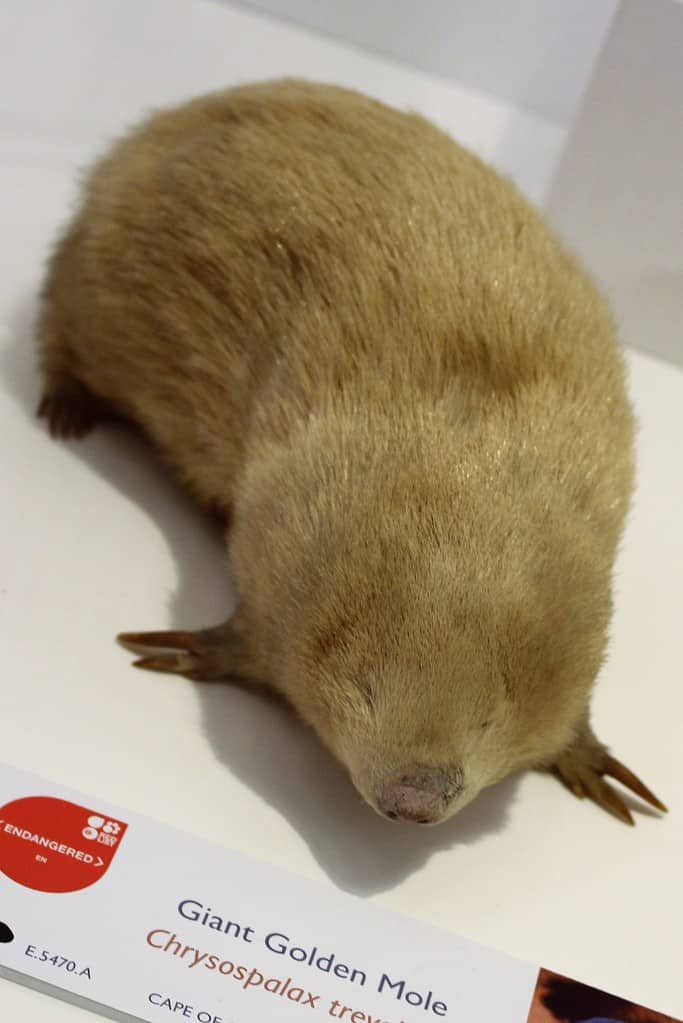The golden mole is so named because of its iridescent coat, which gives it a shining, rainbow-like effect.
Advertisement
Golden Mole Scientific Classification
Read our Complete Guide to Classification of Animals.
Golden Mole Conservation Status
Golden Mole Facts
- Prey
- Insects, mealworms, earthworms, and small vertebrates.
- Main Prey
- Insects
- Group Behavior
- Solitary
- Fun Fact
- The golden mole is so named because of its iridescent coat, which gives it a shining, rainbow-like effect.
- Biggest Threat
- Human habitat disruption
- Most Distinctive Feature
- Iridescent fur
- Gestation Period
- 4 to 6 weeks
- Age Of Independence
- About 6 weeks
- Litter Size
- 1 to 3
- Habitat
- Desert, forest, meadows, and swamps.
- Predators
- Natal black snake, cats, and dogs.
- Diet
- Carnivore
- Lifestyle
- Solitary
- Favorite Food
- Insects
- Special Features
- Iridescent fur
- Origin
- Sub-Saharan Africa
- Number Of Species
- 21
- Location
- Sub-Saharan Africa
- Nesting Location
- Burrows
Golden Mole Physical Characteristics
- Color
- Brown
- Black
- Gold
- Dark Brown
- Chestnut
- Dark Grey
- Skin Type
- Fur
- Lifespan
- Unkown. Some species in captivity have lived two to four years.
- Length
- 3.15 to 9.4 inches.
- Aggression
- High
View all of the Golden Mole images!
Summary
They are a sub-Saharan family of small, burrowing insectivores of 21 species. Though they are not “true moles,” there is a striking resemblance, as they are tailless and blind and have powerful shoulders with short limbs and strong front claws for shoveling dirt or sand.
5 Interesting Golden Mole Facts
- The golden mole is so named because of its iridescent coat, which gives it a shining, rainbow-like effect. The color play results from the flattened, scale-covered hairs, which reflect light in shifting patterns and directions.
- Most need very little water because of highly efficient kidneys and their ability to enter a state of torpor, where their metabolisms slow down, and their body temperatures drop to reduce energy requirements.
- Because they live at or near the capacity of their environment to sustain them, golden moles are considered K-selected species. They have very small litters as a result so that they don’t overrun their environments.
- It is not considered to be a true mole. Unlike the moles of North America, Europe, and Asia, the golden mole likely diverged from its African relative the tenrec millions of years ago.
- A desert dweller, Grant’s golden mole can travel nearly six kilometers in 24 hours when above ground.
Scientific Name
The golden mole is a family (Chrysochloridae) of animals comprising two families and ten genera containing 21 species. The subfamily Chrysochlorinae has a club-shaped large middle ear bone or malleus and includes six genera and 11 species, including the giant golden mole, the rough-haired golden mole, and Grant’s golden mole. Amblysominae have standard-sized and shaped malleus and are found across four genera and ten species, with names including the ordinary-sounding yellow golden mole and the fantastically named Hottentot golden mole. Chrysochloridae belongs to the order Afrosoricida, which includes other African animals, such as otter shrews near the equator and tenrecs from Madagascar. Golden moles are not to be confused with “true moles,” which belong to the family Talpidae of the order Eulipotyphla. The similarities between the two families can be traced to an instance of convergent evolution resulting from functional adaptations of different species to similar environments.
Chrysochloridae is based on the Latin for gold (chrys) and the Greek word for a greenish-yellow color (chlōros.)
Appearance
The golden mole is 8-20 centimeters long and has a thick dirt-repellent coat, which also repels moisture. It has strong shoulders, short legs, powerful claws for digging, and thick skin around its head, which protects it while digging. Around its snout, it has a dry, hairless patch of skin called a rhinarium, which protects the nostrils. Its eyes are functionless and are covered with protective flaps of skin.

Most species of golden mole are nocturnal and live in a collection of underground burrows.
©2,446 × 3,668 pixels, file size: 1.32 MB, MIME type: image/jpeg – License
Behavior
Most species are nocturnal and live in a collection of underground burrows, which they dig, pushing the excess above ground, forming molehills, or packing it into the walls. Burrows near the surface are meant for hunting, while deeper burrows are residential, including latrines, sleeping quarters, and refuges. These tiny burrowers are, for the most part, solitary and highly territorial and will viciously defend their burrow networks. Sometimes, though, there will be some overlap, and a golden mole will take over tunnels adjacent to theirs if they are not in use.
Habitat
They are typically found in Africa below the Saharan desert, mainly in South Africa. It is found in forests, meadows, swamps, deserts, or mountainous regions.
Diet
As insectivores, they will feed on insects while also feeding on worms and vertebrates like small lizards or burrowing snakes. Most will burrow close to the surface, seeking out prey. They can perceive low-frequency vibrations, which lead them to possible food sources. The rough-haired and giant golden mole will forage above ground for their game in forest leaf cover or meadows. Grant’s golden mole hunts above ground in the desert at night for termites which it can only hear when it puts its head in the sand.
Predators and Threats
It is preyed upon by the natal black snake, as well as by dogs and cats. However, the primary threat to the golden mole is habitat loss and damage caused by humans. This includes mining practices and agricultural practices.
Reproduction, Babies, and Lifespan
Golden moles mate during the early portion of the southern dry season, from about April to July. Males will attempt to attract females by combining head shaking, foot stamping, and chirping. Females will respond with squeaking and squealing calls. Several females will mate with a single male and give birth after approximately four to six weeks.
The female will birth one to three hairless newborns in a burrow lined with grass. She will care for and nurse them for a couple of months or so, after which they will be forced from the burrow to begin their independent lives.
The average lifespan in the wild is unknown. There isn’t sufficient data to know this with certainty. However, considering the lifespan of the giant golden mole (four years) and Grant’s golden mole (about two years,) a general lifespan of about two years may be inferred.
Population
There is currently no data on their population status. Many species are considered at least vulnerable. Some species are even found in only one town.
Golden Moles in the Zoo
Due to the endangered status and limited distribution of many golden mole species, there are very few recorded instances of them in captivity. These instances were in laboratories and other scientific institutions. Namib golden moles have been kept in various laboratories for research purposes. Gary Bronner, a professor from the University of Cape Town, has managed to keep several species (Hottentot golden mole, Juliana’s golden mole, and the Cape golden mole) in captivity for a few weeks to two years.
Due to the moles’ territorial nature, it is required that they be housed in separate containers. This will allow enough room for at least one meter of burrowing. The soil should be changed weekly. They should be fed a variety of insects and worms and given water. The species doesn’t require much in the wild, captivity is different. They should also be given diced lamb kidneys to supplement their diets. Room temperature in temperate zones should be adequate for them, as it allows them to go periodically into a state of sleep-like torpor, from which they shouldn’t be disturbed.
View all 170 animals that start with GGolden Mole FAQs (Frequently Asked Questions)
Are golden moles rare?
Though there are 21 species of golden mole as of this date, they are limited to sub-Saharan Africa. The majority of golden mole species are near-threatened or worse. De Winton’s golden mole is critically endangered.
Is a golden mole a rodent?
No. Rodents are of the class Rodentia. Golden moles are members of the class Afrosoricida, which is a mashup of Greek and Latin meaning “looking like African shrews.”
Why are golden moles important?
Golden moles eat potentially harmful insects and other pests. They also condition the soil by turning it over and fertilizing it.
Do golden moles have no eyes?
Golden moles have non-functioning eyes that are covered with skin. Since they are blind, they rely on a keen sense of hearing to detect vibrations from predators and prey.
Can golden moles be pets?
Very few golden moles have been kept in captivity. They are very fragile and will go into torpor if their environment is outside of their ideal range. When they are in torpor, handling them can be very stressful. They don’t make good pets.
Are golden moles territorial?
Golden moles are very territorial and will attack intruders in their burrows.
Do golden moles burrow?
Golden moles create burrows for hunting as well as for residential quarters, latrines, and nurseries. Species that live in sandy habitats will seek prey above ground, as the burrows will collapse.
How many golden moles are left?
It is unknown how many golden moles are alive, though many species are threatened in some way.
How long do golden moles live?
It is unknown how long golden moles live in the wild, though some species in captivity have lived two to four years.
Thank you for reading! Have some feedback for us? Contact the AZ Animals editorial team.
















